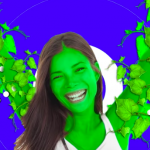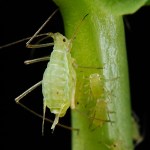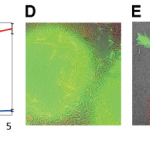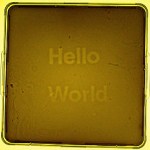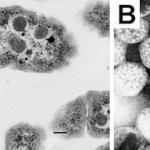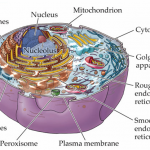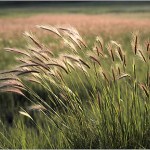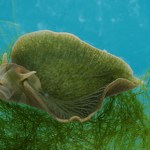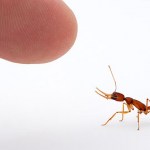photosynthesis
The latest in GMO technology: Photosynthesizing Human Beans!
This is silly, but makes some good points. May be good for teachers in your biology class:
Red pea aphids (Acyrthosiphon pisum); Figure from: Valmalette et al., 2012
In 2010, scientists at the University of Arizona showed that aphids can produce their own carotene. No other animals are known to produce this important antioxidant and must therefore obtain it from their diets. Aphids apparently acquired this ability to produce carotenoids from a fungal gene that was incorporated into their own genome at some point in evolutionary history. Because aphids were shown to produce large amounts of carotenoids, researchers Valmalette et al., wanted to know if the carotenoids…
Symbiosis is everywhere. From the Greek for "living with," symbiosis is simply a close association between two different species in nature. These relationships can be mutualistic, parasitic, or somewhere in between. Bacterial symbionts live inside bodies, like the bacteria that help us and other animals digest our food, and they live inside cells, like the bacteria that live in plant roots and provide their hosts with nitrogen. They can be metabolic, hygienic, or photosynthetic; ectosymbiotic, on the host surface, or endosymbiotic, inside the host's cells. Back in the 1860's biologists…
Earlier this week we talked about how to use whale snot for science.
I especially enjoyed blog bff Scicurious's take on the study:
Budgetary requirement: $5000 for series of expensive remote control helicopters.
Source: Toys R Us.
Justification: Need something that can fly close to a whale and collect snot for measurement. Also, this is the only kind that comes in red, and the gunmetal grey ones suck.
This day, however, we will travel farther, er, south. Through the mouth, down the esophagus, into the stomach, detour through the intestines, take a left at the sphincter, but, what, what's…
Light interacts with and controls biological systems in diverse and fascinating ways. Our eyes are made up of thousands of cells that respond to light, sending signals to our brain as light in different colors and shapes moves across them. Photosynthetic cells are full of receptors that can sense and respond to many wavelengths of light, allowing cells to absorb light for photosynthesis, but also to move towards areas of more sunlight and know when the seasons are changing. Synthetic biology takes these light-responsive systems as parts that can be recombined, shuffled and integrated into…
Carboxysomes are small compartments inside photosynthetic bacteria where the machinery for capturing carbon dioxide is concentrated. You can see carboxysomes and their characteristic virus-like shape when you look at slices of these bacteria under an electron microscope:
Until recently, no one had looked at carboxysomes under the microscope in cells that were still alive. My labmates Dave and Bruno developed a way to label carboxysomes with fluorescent proteins and track them under a microscope as the cells grow, and their amazing paper in Science details some of the fascinating systems they…
Animal cells are made up of many smaller membrane-bound compartments called organelles that perform highly specialized functions necessary for life. Incredibly, several of these organelles have been shown to be evolutionarily related to free-living bacteria, captured and incorporated inside a larger cell billions of years ago in a complex mutually beneficial relationship, known as endosymbiosis (a partnership between two species where one of the species is inside the other). The mitochondria that power our cells, generating energy by breaking down sugars are in fact relatives of regular old…
I am kind of obsessed with symbiosis and the idea that cooperation between different species can be a driver of evolutionary change. I learned about these symbiotic green sea slugs a while back from a colleague whose mom is a zoologist who studies the evolution of symbiosis between invertebrates and photosynthetic microorganisms. A review article from her lab beautifully introduces the amazing properties of Elysia chlorotica:
Faced with life without a protective shell in a predatory environment, some sea slugs evolved a protective mechanism dependent largely upon camouflage pro- vided by…
If you enjoy bioephemera, you should take a moment to check out Scienceblogs' new blog, Photo Synthesis:
While doing our usual browsing of the blogosphere, we've become aware of the vast number of excellent blogs featuring science imagery, from neural networks captured with a light microscope to images of supernovae billions of light-years away. To take advantage of this wealth of visual content, we've decided to host our favorites here on ScienceBlogs, with a rotating line-up of photobloggers we'll select monthly.
This month, Alex Wild of myrmecos kicks things off with his insect…
Tigers can no more change their stripes than leopards can change their spots. That's a good thing too, for their unchanging patterns, as individually distinct as a human fingerprint, make it easier to track any single tiger over time.
That process is about to become even simpler with a computer programme that creates a three-dimensional model of a tiger's skin and can compare different shots of an animal taken at different times or angles. The programme is the brainchild of Lex Hilby from an organisation called Conservation Research and it could allow conservationists to track surviving…
Solar power is a relatively new development for humans but, of course, many living things have been exploiting the power of the sun for millions of years, through the process of photosynthesis. This ability is usually limited to plants, algae and bacteria, but one unique animal can do it too - the emerald green sea slug Elysia chlorotica. This remarkable creature steals the genes and photosynthetic factories of a type of algae that it eats (Vaucheria littorea), so that it can independently draw energy from the sun. Through genetic thievery, it has become a solar-powered animal and a…
